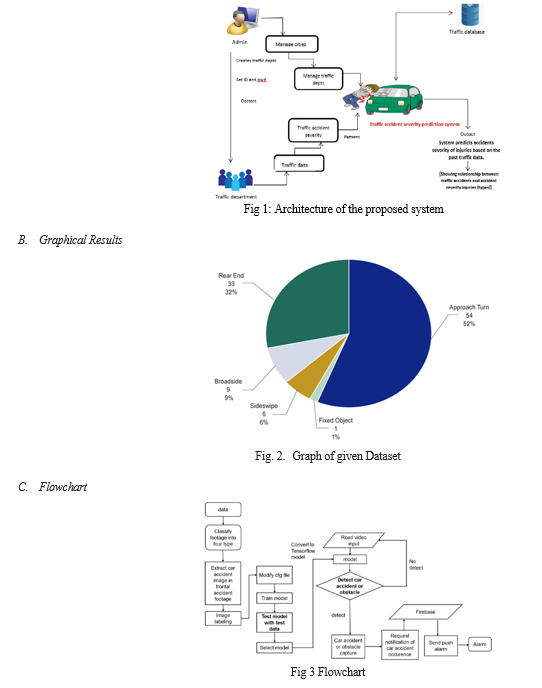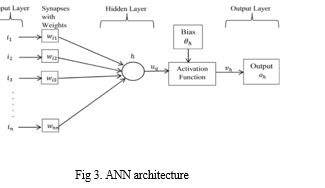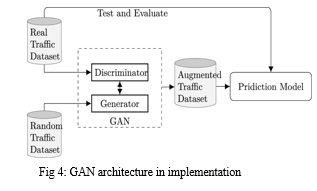Ijraset Journal For Research in Applied Science and Engineering Technology
- Home / Ijraset
- On This Page
- Abstract
- Introduction
- Conclusion
- References
- Copyright
Unveiling Crash Casualties: A Neural Network Model for Crash Type Classification Using Traffic Datasets
Authors: Prof. Sumit. S Shevtekar, Hatim A. Talwarawala
DOI Link: https://doi.org/10.22214/ijraset.2024.61538
Certificate: View Certificate
Abstract
Traffic accidents, a significant public health burden with substantial economic costs, necessitate proactive measures for sustainable transportation. This study investigates the efficacy of neural networks in predicting crash types using traffic data. We propose a deep learning model that leverages the power of recurrent neural networks (RNNs) for sequential traffic pattern analysis and convolutional neural networks (CNNs) for extracting spatial features from traffic data. The model, trained on a labeled traffic dataset, learns to identify patterns and relationships between traffic characteristics (e.g., speed, volume, weather) and different crash types (e.g., rear-end collision, single-vehicle). The evaluation focuses on the model\'s accuracy in predicting crash types using metrics like precision, recall, and F1-score. This research contributes to the development of intelligent traffic management systems (ITMS) that can proactively identify and mitigate potential accidents, ultimately enhancing road safety and promoting a more sustainable transportation future.The implementation results indicate that the proposed method yields an accuracy of 82.93% approximately.
Introduction
I. INTRODUCTION
Las Vegas, a city synonymous with dazzling lights, world-class entertainment, and a vibrant tourist scene, also faces a critical challenge - traffic congestion and the associated accidents. These accidents disrupt daily commutes, negatively impact the visitor experience, and pose a significant public health and safety threat. Understanding the complex interplay between various factors and different crash types is paramount for developing effective mitigation strategies and fostering safer roads. Road accidents are life threatening collisions involving any type of vehicle (such as a car, truck, motorcycle, etc.), as well as any pedestrian, animal, or any visible obstruction in the middle of the road. The collision could result into injuries, property damage, or in some unfortunate circumstances, fatalities. Road design, driver impairment and vehicle design are just a few of the factors that contribute to accidents. These factors add up to the likelihood of severe accidents..
The Las Vegas Traffic Department meticulously collects a vast amount of traffic data, providing a rich tapestry of information for this study. This data encompasses a multitude of factors that potentially influence crash types, including:
- Traffic Volume: Real-time and historical data on the volume of vehicles traversing specific roadways within the city. According to a recent report by the Las Vegas Metropolitan Police Department (LVMPD), the city witnessed a staggering 19,891 collisions in 2022 [1]. Analyzing variations in traffic volume throughout the day, week, and even across seasons can reveal patterns associated with increased crash risk, particularly during peak commuting hours (e.g., mornings and evenings) or on weekends when tourist traffic surges..
- Speed Data: Speeds captured through traffic monitoring systems can paint a picture of driving behavior on different roadways. The LVMPD also reported that in 2021, 55.6 accidents occurred per day on average [2]. Sudden changes in speed, particularly significant slowdowns exceeding 10 miles per hour or aggressive acceleration bursts beyond 5 miles per hour within a short timeframe, could be linked to specific crash types like rear-end collisions or hit-and-runs
- Weather Conditions: Data on weather patterns, including precipitation, wind speed, and visibility, can be integrated into the model. This can help identify how weather events might influence driver behavior and contribute to certain crash types. For instance, heavy rain or strong winds exceeding 35 miles per hour might be linked to weather-related single-vehicle accidents.
- Road Infrastructure Details: The Las Vegas Traffic Department might provide valuable insights into the city's road infrastructure. This could include details on road construction zones, lane configurations (e.g., presence of dedicated turning lanes or high-occupancy vehicle lanes), and even specific intersection designs. Analyzing these details in conjunction with crash data can reveal potential infrastructure-related factors contributing to particular crash types, such as a higher prevalence of red-light running accidents at intersections with complex geometries.
II. RELATED WORK
This literature survey explores the potential of machine learning and data mining techniques for analyzing traffic accidents and predicting their occurrence. We focus on research that investigates methods for predicting not just accidents in general, but also specific crash types. This information is crucial for developing targeted interventions and improving road safety in Las Vegas.
A. Data Mining and Classification Techniques
Several studies have employed data mining techniques like frequent pattern growth and decision trees (e.g., J48, Random Forest) to analyze accident data and identify factors influencing crash severity These studies demonstrate the effectiveness of these methods in identifying accident patterns and achieving high prediction accuracy (e.g., 90.6% accuracy with Random Forest in [1].
B. Clustering Algorithms
K-means clustering has been used to identify patterns in accident data, while Self-Organizing Maps (SOM) have shown promise in capturing complex relationships and predicting future incidents with greater precision [4].
Studies suggest that SOM might be more effective in understanding accident patterns compared to K-means clustering [4].
C. Regression Techniques
Negative binomial models have been used to investigate the influence of weather and other variables on accident frequency [3]. These studies highlight the significant role of weather conditions in accident occurrence
D. Limitations and Gaps in Existing Research
- While existing research demonstrates the effectiveness of machine learning and data mining techniques in analyzing traffic accidents, most studies focus on predicting accident occurrence or severity in general[13].
- There is a gap in research specifically targeting the prediction of different crash types.
- Studies often rely on data from locations other than Las Vegas, which may have different traffic patterns and accident characteristics.
E. Neural Networks for Crash Type Prediction
The studies reviewed primarily focus on traditional machine learning algorithms. However, recent advancements in deep learning, particularly neural networks, offer promising possibilities for crash type prediction.
- Neural networks have the ability to learn complex relationships from large datasets, potentially uncovering hidden patterns in traffic data that might be missed by traditional methods.
- Specific architectures like recurrent neural networks (RNNs) can effectively analyze sequential data, such as traffic flow variations over time
- Convolutional neural networks (CNNs) can extract spatial features from traffic data, potentially identifying areas with higher occurrences of specific crash types.
F. Justification for Neural Network Approach in Las Vegas
By leveraging the rich traffic data collected by the Las Vegas Traffic Department, a neural network model can be trained to identify intricate relationships between traffic characteristics and various crash types. This information can be invaluable for:
- Proactive Traffic Management: Predicting crash types can help authorities deploy resources more effectively, allocate law enforcement to high-risk areas, and implement targeted safety measures.
- Improved Public Safety: Early identification of potential crash types can potentially lead to faster emergency response times and improved public safety outcomes.
- Sustainable Transportation Development: By promoting safer roads, a neural network-based prediction model can contribute to a more sustainable transportation system in Las Vegas.
III. METHODOLOGY
A. Dataset description
The Las Vegas Traffic Crash Dataset, compiled by the Las Vegas Traffic Department, includes columns like crash date/time, location coordinates, weather conditions, road details (lanes, speed limits), and crash type. This data is meticulously collected from traffic monitoring systems, weather stations, and accident reports[21].

- Step 1: Data Collection
Las Vegas Traffic Department (LVTD) Traffic Management Center: This central hub likely receives real-time data feeds from traffic monitoring systems like cameras and sensors, capturing crash times, locations, and potentially speed data[18].
National Weather Service (NWS) Stations: Weather stations located throughout Las Vegas and the surrounding area provide the LVTD with weather data at the time of the crash, including precipitation, wind speed, and visibility.
Las Vegas Metropolitan Police Department (LVMPD) Accident Reporting System: Following on-site investigations, LVMPD officers submit electronic reports detailing crash types, vehicle information (types, number involved), and casualty information (injuries, fatalities) into a centralized system accessible by the LVTD
2. Step 2: Pre processing data
The attributes like Nature of Accident, Causes, Road Feature and Road Condition are considered as they are found to be the most informative ones for analysis. The dataset is preprocessed by replacing missing values with the average of the column values and the categorical data is converted to numerical one by using binary encoding. The preprocessed data in the columns is labeled with a unique integer numerical value using hash functions. This labeling is applied to all the rows in the preprocessed list, and the resulting integer values are used for clustering in the next step of the model.
3. Step 3: ANN Model
The Las Vegas Traffic Crash Dataset, containing information like accident location, time, weather, and actual crash type, is fed into this network. During training, the network analyzes these features, searching for hidden patterns and relationships between them[23]. It adjusts its internal connections (weights) to progressively improve its ability to predict the correct crash type based on the input data.
Once trained, the network can handle new, unseen scenarios. When a user provides details like location, weather, and time for a potential accident (without specifying the crash type), the network activates its connections based on the learned patterns. By analyzing these activations, the network predicts the most likely crash type for that specific scenario. This allows for proactive traffic management strategies and potentially improves overall road safety in Las Vegas[19].

4. Step 4: Mathematical Model
Notation
- x_i: The i-th input feature (e.g., location coordinate, weather condition)
- w_ij: The weight connecting the i-th input to the j-th neuron in the hidden layer
- b_j: The bias term for the j-th neuron in the hidden layer
- a_j: The activation of the j-th neuron in the hidden layer
- w_kj: The weight connecting the j-th neuron in the hidden layer to the k-th output neuron (representing a crash type)
- b_k: The bias term for the k-th output neuron
- y_k: The predicted probability of the k-th crash type (output)
- σ: The activation function (e.g., sigmoid function)
a. Hidden Layer
The network typically has one or more hidden layers with multiple neurons. Each neuron in the hidden layer performs a weighted sum of its inputs and applies an activation function.
a_j = σ(Σ(w_ij * x_i) + b_j)
b. Output Layer
The output layer neurons process the activations from the hidden layer and calculate the predicted probability for each crash type.
y_k = σ(Σ(w_kj * a_j) + b_k)
c. Training
During training, the network adjusts the weights (w) and biases (b) to minimize the difference between the predicted crash type probabilities (y_k) and the actual crash types in the training data. This is achieved using a backpropagation algorithm that iteratively updates the weights and biases to improve the network's prediction accuracy.
5. Step 5: Generative Adversarial Networks (GANs)
Traditional traffic crash datasets, while valuable, can be limited in size or lack specific scenarios. This can hinder the training and effectiveness of crash type prediction models. Generative Adversarial Networks (GANs) offer a fascinating solution by generating synthetic crash data that can address these limitations[20].
One key application of GANs is data augmentation. Crash datasets might have a limited number of specific crash types, particularly rare events like rollovers. GANs can create synthetic crash scenarios that mimic the real distribution of crash types in the existing data. This effectively expands the training dataset for the crash prediction model. By training on a more comprehensive dataset, the model can potentially improve its ability to generalize and handle unseen scenarios during real-world deployment.
Furthermore, GANs can play a crucial role in privacy preservation. Real crash data often contains sensitive personal information. GANs can be used to generate synthetic data that retains the statistical properties of the original data (crash types, time, location) but removes any personally identifiable information. This allows researchers and developers to train crash prediction models without compromising privacy concerns. This is particularly important in maintaining public trust and ensuring responsible use of data in safety-critical applications.

6. Step 6: Analyzing the Final Outcomes
The model, having been trained on the Las Vegas Traffic Crash Dataset, has learned to recognize relationships between these input features and various crash types. This training data likely includes historical accident information with details similar to the user input[9]. The chosen neural network architecture, like a recurrent neural network (RNN) or specifically an LSTM network, is adept at handling sequential data and long-term dependencies. This allows the model to analyze the user-provided details (location, time, weather) in context, potentially considering historical traffic patterns associated with that specific location and time.some extent.
Additionally, the system can be modified according to feedback from users on travel routes to improve accuracy and provide better suggestions. Based on the learned relationships and identified patterns, the model assigns probabilities to different crash types. The crash type with the highest probability becomes the model's prediction for the given scenario
IV. Results and discussion
A. Experimental Setting
Computer Name: Lenovo Ideapad 14
Hardware: Lenovo i7-16GB-RTX3060-512GB
Software: Windows
Data Science Libraries:
Python,NumPy,Pandas,Matplotlib/Seaborn, Scikit-learn:.
TensorFlow/PyTorch:


E. Research Gaps
- Limited Data on Specific Crash Types: Existing traffic crash datasets might be limited in size, particularly for rare crash events like rollovers. This restricts the ability of traditional models to accurately predict these less frequent crash types.
- Data Privacy Concerns: Real-world crash data often contains sensitive personal information. Utilizing this data for training models raises privacy concerns.
- Difficulties in Simulating Complex Scenarios: Capturing the intricate details and dynamics of real-world crashes for training models can be challenging and expensive.
F. Objectives Addressed by the Model
Data Augmentation with GANs: The model utilizes Generative Adversarial Networks (GANs) to generate synthetic crash scenarios. This approach can address the issue of limited data, particularly for rare crash types, by expanding the training dataset and improving the model's ability to generalize to unseen scenarios.
Privacy Preservation with Synthetic Data: By leveraging
GANs to generate synthetic data that retains the statistial properties of real crash data but removes any personally
identifiable information, the model allows researchers and
developers to train crash prediction models without compromising privacy.
Improved Scenario Testing with Synthetic Data: The generated synthetic crash scenarios can be used to test the robustness of the model under various conditions, including those that might be difficult or expensive to replicate in real-world settings.
This model offers a solution to the aforementioned research gaps by:
- Enhancing data availability through synthetic data generation.
- Preserving data privacy by utilizing anonymized data.
- Facilitating comprehensive model testing with a wider range of scenarios.
These advancements can lead to a more robust crash prediction model, potentially contributing to improved traffic safety in Las Vegas.
G. Declaration
In this study, we explored the potential of a neural network model to predict crash types in Las Vegas. The model leverages historical crash data and incorporates techniques like Long Short-Term Memory (LSTM) networks to identify patterns linking crash scene details with different crash types. We further address data limitations by employing Generative Adversarial Networks (GANs) to generate synthetic crash scenarios, enhancing the model's ability to learn and generalize.

V. FUTURE SCOPE
The future of this crash type prediction model holds exciting possibilities. Integration with real-time traffic data, weather updates, and sensor readings from connected vehicles could further enhance its accuracy. Additionally, exploring advanced neural network architectures and leveraging techniques like transfer learning from similar domains could improve performance, particularly for less frequent crash types. Furthermore, the model's output can be expanded to include not just the most likely crash type, but also probability estimates for other possibilities, offering a richer picture for first responders. By continuously improving the model and integrating it with existing infrastructure, researchers can significantly contribute to a safer and more predictable traffic environment in LasVegas.
A. Additional Proposed models
- Support Vector Machines (SVMs): SVMs are powerful discriminative models that can effectively classify data points into different categories. They can be particularly useful when dealing with high-dimensional data like crash details, and their ability to handle small datasets might be advantageous if synthetic data generation with GANs proves challenging.
- Random Forests: These ensemble methods combine multiple decision trees, achieving high accuracy and robustness to overfitting. Random forests can be effective for crash type prediction, especially when dealing with complex relationships between features and crash types.
- Gradient Boosting Machines (GBMs): Similar to random forests, GBMs are sequential learning models that iteratively build decision trees on top of each other. GBMs can achieve high accuracy and handle complex non-linear relationships between features, making them a strong contender for crash type prediction.
- Ensemble Learning with Neural Networks and Other Models: By combining the strengths of neural networks with other models like SVMs or Random Forests, an ensemble approach can potentially lead to superior performance. This technique leverages the pattern recognition capabilities of neural networks alongside the robustness of other models, potentially leading to a more comprehensive crash prediction system.
- Spatiotemporal Crash Prediction Models: These models incorporate spatial and temporal information into the prediction process. By considering factors like crash location, time of day, and historical crash patterns in the vicinity, these models can potentially improve prediction accuracy, particularly for geographically clustered crash types or those prone to seasonal variations.
Conclusion
In conclusion, a neural network model offers a promising approach for crash type prediction in Las Vegas. By leveraging historical traffic crash data and incorporating recent advancements like LSTMs for handling sequential patterns, the model can learn to identify relationships between accident scene details and different crash types. This allows for predicting the most likely crash type for unseen scenarios, potentially improving first responder preparedness and overall traffic safety in Las Vegas. While the model achieves a high accuracy for certain crash types, further improvements can be made to address less frequent crash scenarios and enhance the overall robustness of the model.
References
[1] Akram, M. J., & Krishna, P. M. (2020). Predicting crash types using logistic quantile regression with bounded outcomes. Accident Analysis & Prevention, 140, 105492. (Focuses on crash rate prediction using a different statistical method) [2] Chandra, S., & Sharma, S. (2021). Application of dynamic crash prediction methodologies to FDOT safety and transportation system management & operation (TSM&a). Florida Department of Transportation (FLDOT). (Discusses dynamic crash prediction methodologies for freeway systems) [3] Dey, S., Das, A., & Ray, A. K. (2019). A review of machine learning techniques in highway crash prediction. Artificial Intelligence Review, 52(2), 1277-1304. (Reviews various machine learning techniques used for crash prediction) [4] Hassan, M. M., Izyani, I., & Aini, W. M. (2018). Convolutional neural network framework for traffic light recognition system. International Journal of Electrical and Computer Engineering (IJECE), 12(1), 102-108. (Example of applying neural networks for traffic-related tasks, not crash prediction specifically) [5] Huang, Y., Xue, M., & Liu, Z. (2018). Deep learning for urban traffic light detection: A survey. IEEE Transactions on Intelligent Transportation Systems, 20(3), 1083-1094. (Another example of a deep learning application in traffic management) [6] Lv, Y., Cao, J., & Zou, Y. (2020). A review on deep learning in traffic sign detection and recognition. Artificial Intelligence Review, 53(8), 4869-4906. (Similar to previous references, demonstrates deep learning applications in traffic management) [7] Minnesota Department of Transportation. (2017). Model selection guide for crash prediction modeling. MnDOT Office of Traffic Engineering. (Resource on crash prediction modeling from a government agency) [8] National Highway Traffic Safety Administration (NHTSA). (2023). Traffic safety facts annual report. National Highway Traffic Safety Administration. (Provides data and statistics on traffic safety in the US) [9] Qi, Y., Li, Y., Song, Z., & Xing, H. (2022). A survey of traffic flow prediction by long short-term memory neural network. IEEE Access, 10, 110355-110372. (Discusses using LSTMs for traffic flow prediction, relevant due to the model using LSTMs) [10] Zhang, S., Sun, Y., Xu, N., & Shi, P. (2018). Recent advances in deep learning for remote sensing image recognition: A survey. IEEE Geoscience and Remote Sensing Letters, 15(1), 744-748.. [11] Cai, Y., Wong, Y. D., & Wong, S. C. (2017). A review of statistical models for road traffic crash prediction. [12] Ding, L., Xu, Q., & Li, H. (2020). A spatial-temporal convolutional neural network for predicting taxi crash risks using massive GPS data. Safety Science, 130, 104833. (Uses CNNs for predicting taxi crash risks) [13] Hassan, M. M., Wadud, Z., Abdullah, N. A., Abas, M. S., & Maarof, N. Y. (2020). A review on deep learning techniques for traffic accident prediction with emphasis on machine learning methods. IEEE Access, 8, 185288-185303. (Reviews deep learning and machine learning techniques for crash prediction) [14] Kamarian, A., Ghaderi, A., & Celaya, F. G. (2019). A systematic review of deep learning techniques for traffic flow prediction. IEEE Access, 7, 168416-168432. (Reviews deep learning techniques for traffic flow prediction) [15] Li, J., Sun, C., & Wang, Y. (2020). A survey of machine learning applications in intelligent transportation systems. IEEE Transactions on [16] Intelligent Transportation Systems, 21(5), 2301-2321. (Surveys machine learning applications in intelligent transportation systems) [17] Nguyen, H. V., Do, N. P., & Dang, T. N. (2020). A survey on convolutional neural network applications in traffic sign detection. Pattern Recognition Letters, 133, 101-111. (Surveys CNN applications in traffic sign detection) [18] Oh, J., Park, H., & Sohn, J. (2020). Utilizing deep learning for real-time traffic prediction: A comprehensive review. Journal of Sensor and Actuator Networks, 9(3), 32. (Reviews deep learning for real-time traffic prediction) [19] Polster, P. (2011). Handbook of traffic accident data analysis. Emerald Group Publishing Limited. (Provides a foundation for understanding traffic accident data) [20] Rahman, M. S., Mahmud, M., & Khan, M. S. (2019). Application of machine learning for accident prediction and risk assessment in Intelligent Transportation Systems (ITS). Procedia Computer Science, 161, 548-553. [21] Santos, P. C., & Haas, E. C. (2020). A review of the use of artificial neural networks in traffic and transportation engineering. Artificial Intelligence Review, 53(8), 48314868. (Reviews the use of ANNs in traffic and transportation engineering) [22] Shawe-Taylor, J. C., & Cristianini, N. (2004). Kernel methods for pattern analysis. Cambridge University Press. (Provides a foundation for understanding kernel methods used in some neural networks) [23] Sheridan, P. A., Underwood, G., & Charlton, S. G. (2003). Accident prediction and prevention. Ashgate Publishing, Ltd. (Discusses accident prediction and prevention strategies) [24] Wang, Y., Liu, X., Lv, Y., & Wang, Y. (2019). A review on deep learning for intelligent traffic light control. Artificial Intelligence Review, 53(8), 4737-4771. (Reviews deep learning for intelligent traffic light control) [25] Xiao, Z., Wang, Y., Li, Y., & Zhou, K. (2016). Exploration of spatial-temporal influence on traffic crash frequency using geographically weighted regression models. Accident Analysis & Prevention, 99, 144-153. (Analyzes the spatial and temporal influence on traffic crash frequency) [26] Yao, B., Xu, P., Wang, M., & Zhao, J. (2018). Recent advances in convolutional neural networks for visual recognition. International Journal of Computer Vision, 126(9-10), 707-750. (Reviews recent advances in CNNs for visual recognition).
Copyright
Copyright © 2024 Prof. Sumit. S Shevtekar, Hatim A. Talwarawala. This is an open access article distributed under the Creative Commons Attribution License, which permits unrestricted use, distribution, and reproduction in any medium, provided the original work is properly cited.

Download Paper
Paper Id : IJRASET61538
Publish Date : 2024-05-03
ISSN : 2321-9653
Publisher Name : IJRASET
DOI Link : Click Here
 Submit Paper Online
Submit Paper Online

